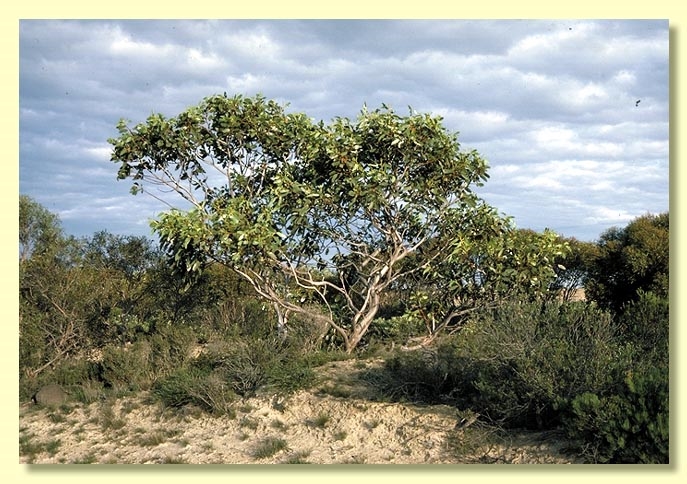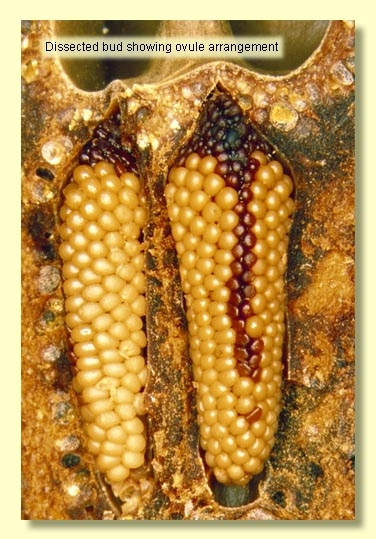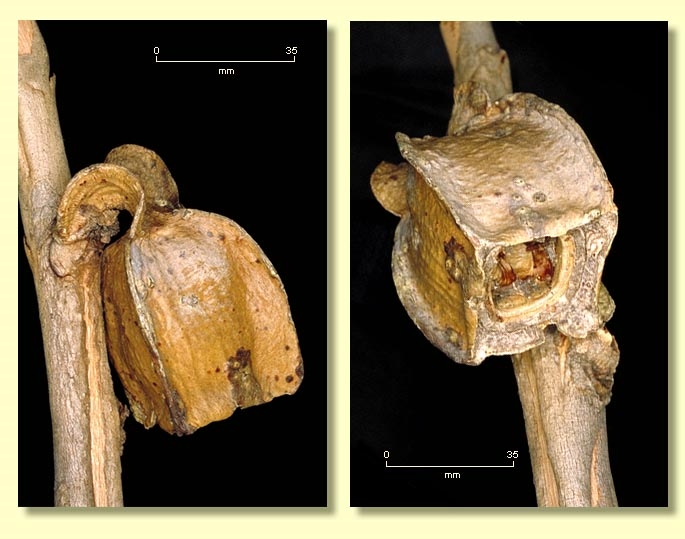Euclid - Online edition
Eucalyptus tetraptera
Eucalyptus | Symphyomyrtus | Dumaria | Tetrapterae
T: Swan River to King George Sound, W.A., J.Drummond 4: 71; holo: LE; iso: BM, CGE, FI, G, K, PERTH.
Eucalyptus acutangula Turcz., Bull. Cl. Phys.-Math. Acad. Imp. Sci. Saint-Pétersbourg 10: 338 (1852). T: Swan River to Cape Riche, W.A., J.Drummond 189; holo: KW; iso: BM, CGE, FI, G, MEL.
Bark smooth throughout, rarely with semi-persistent broad ribbons for ca 0.3 m of trunk, mottled dark and pale grey to silvery grey.
Branchlets square in cross-section; lacking oil glands in the pith.
Juvenile growth (coppice or field seedlings to 50 cm): stems rounded in cross-section juvenile leaves always petiolate, alternate, ovate to elliptical, 5–12 cm long, 2.5–7 cm wide, dull, green, becoming glossy.
Adult leaves coarse, thick, alternate, petioles 2–4.5(6.3) cm long; blade lanceolate to oblong, 9–20(28.5) cm long, 2.8–7.5(11.6) cm wide, base tapering to petiole or rounded, margin entire, apex pointed, concolorous, glossy, green, side-veins greater than 45° to midrib, reticulation dense, intramarginal vein remote from margin, oil glands intersectional, few or absent.
Inflorescence axillary unbranched, peduncles rigidly down-turned, with broadly curved wings, often wider than long, 0.5–6 cm long; bud solitary, sessile. Mature buds cuboid with 4 broad wings at the angles (3.4–6.5 cm long, 2–4 cm wide), hypanthium red, scar present (outer operculum shed early), operculum pyramidal (1.5–3 cm long), stamens inflexed, filaments glandular, anthers cuboid, versatile, sub-basifixed, dehiscing by longitudinal slits, style long and straight, stigma tapered, locules 4, the placentae each with 10 or 12 vertical rows of ovules or the rows indistinct. Flowers red to pink.
Fruit on rigidly down-turned peduncles, sessile, rarely shortly pedicellate to 0.5 cm long, cuboid and prominently winged, 3.5–5.5 cm long, 2.5–5.5 cm wide (including wings), disc descending vertically, valves 4, enclosed.
Seeds black, 3.5–6 mm long, shortly pyramidal to obliquely pyramidal, with prominent ridges continuous with conspicuous marginal flange, dorsal surface shallowly reticulate, hilum terminal.
Cultivated seedlings (measured at ca node 10): cotyledons reniform; stems rounded to square in cross-section; leaves always petiolate, opposite for 2 to 4 nodes then alternate, ovate to broadly lanceolate, 5–9.5 cm long, 2.5–4.5 cm wide, dull. Green.
Flowering has been recorded in January, February, May, September, October and November.
Occasionally grown as an unusual ornamental because of its low growth form, large glossy leaves and red buds.
A straggly mallee endemic to Western Australia, of coastal and subcoastal distribution in heathlands on sandy to gravelly soils from the Stirling Range in the west towards Israelite Bay in the east, including the slopes of Mt Ragged. It has the thickest leaves of any eucalypt and large 4-winged, squared buds and fruit.
Eucalyptus tetraptera belongs in Eucalyptus subgenus Symphyomyrtus section Dumaria because the buds have two opercula, stamens are strongly inflexed, ovules are in 10 or 12 rows on the placentae and cotyledons are reniform. E. tetraptera forms a small subgroup (series Tetrapterae) with E. stoatei, E. forrestiana, E. dolichorhyncha, E. brandiana and E. sweedmaniana, all bearing single-flowered inflorescences and with the buds having a red base when mature, all lacking oil glands in the pith of the branchlets, and have seed that is blackish, pyramidal, with marginal flange. E. tetraptera, E. brandiana and E. sweedmaniana have pink-red stamens while E. stoatei, E. forrestiana and E. dolichorhyncha all have yellow stamens.
Sporadically in heath between the Stirling Range and Israelite Bay occasional hybrids occur, E. x erythrandra, with E. tetraptera as one parent and probably E. angulosa, E. incrassata or E. captiosa as the other parent. See E. x erythrandra for details.
In 2009 Hopper and McQuoid described two exciting new species closely related to Eucalyptus tetraptera, namely E. brandiana and E. sweedmaniana, both restricted endemics in southern cosatal Westerm Australia, within the general geographic range of E. tetraptera. E. brandiana is a slender emergent mallet (lacks a lignotuber) found in coastal heath and is otherwise similar to the mallee E. tetraptera but with slightly larger leaves, buds and fruits. E. sweedmaniana is a prostrate lignotuberous shrub with smaller leaves buds and fruits than E. tetraptera and E. brandiana.
Habit
Seedlings
Adult leaves cm
Fruit cm (incl wings)
tetraptera
lignotuber, upright mallee rarely prostrate
erect
9–28 x 2.8–11.6
3.5–6.6 x 2.5–5.5
brandiana
no lignotuber, erect mallet habit
erect
14–23.8 x 4.2–6.2
5.6–6.8 x 4.8–6
sweedmaniana
lignotuber, decumbent to prostrate shrub
prostrate
16.5–26.3 x 4.5–6.7
3.4–3.8 x 3–4.1
Data after CANB specimens and Hopper & McQuoid (2009).















